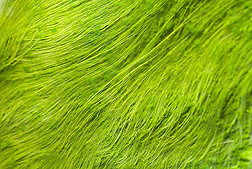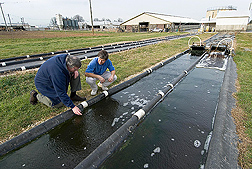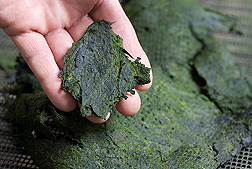Algae
A Mean, Green Cleaning Machine
It sounds like a late-night infomercial pitch: a plant that grows at a monstrous pace in polluted water, soaks up CO2, and cleans up manure runoff.
Agricultural Research Service microbiologist Walter Mulbry has been finding out there’s more to algae than just stringy masses that muck up streams and ponds. Though some scientists believe algae might be the next best thing in biofuel production, Mulbry thinks it can be used right now to reduce the nitrogen and phosphorus in livestock manure—and then dried and sold as a slow-release fertilizer.
Livestock manure is used as a cheap and abundant field-crop fertilizer because it contains large amounts of nitrogen and phosphorus, which are both essential plant nutrients. But some of the nitrogen and phosphorus that isn’t used by the crops can be washed into nearby streams and rivers and end up in the Chesapeake Bay.
Like cultivated field crops, aquatic plants grow and flourish when nitrogen and phosphorus are plentiful. When these plants die, their decomposition robs the bay of oxygen, which in turn harms other aquatic life. A 2005 report by the Chesapeake Bay Foundation, whose motto is “Save the Bay,” estimated that animal manure contributes 18 percent of the nitrogen and 27 percent of the phosphorus that drain into the Chesapeake Bay every year.
“Other researchers have looked at using algae-based systems to clean up municipal wastewater and other types of polluted water,” says Mulbry, who is with the ARS Environmental Management and Byproduct Utilization Research Laboratory in Beltsville, Maryland.
“So we built on that concept and focused on tracking manure nitrogen and phosphorus through the treatment system. Nutrient recovery values—comparison of the amounts of manure nitrogen and phosphorus that are added to the system with the amounts of algal nitrogen and phosphorus removed from the system—are surprisingly difficult to measure in the field because of frequent changes in manure characteristics.”
In 2003, Mulbry set up four algal turf scrubber (ATS) raceways outside dairy barns at the ARS Henry A. Wallace Beltsville Agricultural Research Center. The shallow, 100-foot-long raceways were covered with nylon netting on which the algae grew. Then for the next 3 years, from April until December, submerged water pumps at one end of the raceways circulated a mix of fresh water and raw or anaerobically digested dairy manure effluent over the algae.
Just Add Water and Stir
Within 2 to 3 weeks after the ATS system was started up each spring, the raceways supported thriving colonies of green filamentous algae, including Rhizoclonium hieroglyphicum—the most abundant algae species, and Microspora willeana, Ulothrix ozonata, and Oedogonium sp. Algae growth was highest in the spring and declined during the summer months in part because of the higher water temperatures and also because the raceways provided snails and midge larvae ample opportunity to graze on the algae.
Working with postdoctoral researcher Elizabeth Kedebe-Westhead and others, Mulbry harvested wet algae every 4-12 days, dried it, and then analyzed it for nitrogen and phosphorus levels. Results indicate that the ATS system recovered 60 to 90 percent of the nitrogen and 70 to 100 percent of the phosphorus from the manure effluents.
“When we use ATS management, we are able to remove the nutrients completely,” Mulbry says. But he also notes that, unlike other management practices, ATS systems have high capital costs and require people onsite to harvest the algae. Even so, Mulbry calculated that the cost for this capture was comparable to other manure-management practices—around $5 to $6 for each pound of recovered nitrogen and around $25 for each pound of recovered phosphorus.
The potential benefits don’t stop with nutrient capture. Mulbry also studied whether the dried algae had potential as an organic fertilizer. He found that corn and cucumber seedlings grown in algae-amended potting mixes performed as well as those grown with commercial fertilizers.
“It’s possible that farmers using ATS management could sell the dried algae as an organic fertilizer for use by urban and suburban residents. It’s a ready-made ‘Save the Bay’ fertilizer,” Mulbry says.
The Not-So-Distant Shore
Now Mulbry is partnering with University of Maryland scientist Patrick Kangas and researchers from the State of Maryland and Caroline County on a study under way on Maryland’s Eastern Shore. They want to see whether farmers there who use poultry litter for fertilizer can also use ATS systems to clean up nitrogen and phosphorus runoff in field ditches.
Maryland’s Eastern Shore—where five counties are among the leaders of broiler production in the United States—has hundreds of miles of managed drainage ditches and in-field connectors crisscrossing thousands of acres of cropland. In 1999, the Public Drainage Task Force in Maryland was charged with developing recommendations for changing public-drainage management, which would help reduce the amount of agricultural pollutants flowing into the Chesapeake Bay.
Mulbry is contributing to the study of different ATS systems to identify the most important factors in designing a cost-effective approach to their use in ditch management. “We’re looking at several approaches,” he says. “How do we make this as cheap as possible? How does it compare, cost-wise, with other management practices? And what would a business plan look like to the service provider and to the farmer?”
Mulbry also conducted a study to see how effective ATS systems are at removing nitrogen and phosphorus from three estuaries that drain into the Chesapeake Bay. “We started out treating manure on the farm to prevent pollutants from entering the watershed,” he says. “Now we’re looking at ways to capture pollutants after they’ve left the farm and are on their way to the bay.”—By Ann Perry, Agricultural Research Service Information Staff.
This research is part of Manure and Byproduct Utilization (#206) and Food Safety (#108), two ARS national programs described at www.nps.ars.usda.gov.
Walter Mulbry is in the USDA-ARS Environmental Management and Byproduct Utilization Laboratory, 10300 Baltimore Ave., Bldg. 306, Beltsville, MD 20705; (301) 504-6417.
"Algae: A Mean, Green Cleaning Machine" was published in the May/June 2010 issue of Agricultural Research magazine.









